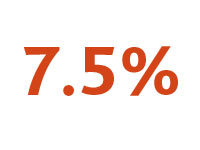
Just 7.5% of adults with learning disabilities known to English councils are in paid employment, lower than the government previously thought.
The figure was published last week by the NHS Information Centre as part of provisional information on council performance against national adult social care indicators for 2008-9.
Valuing Employment Now, the Department of Health’s learning disability employment strategy published in June, estimated that 10% of people with learning disabilities known to councils were in paid work.
Well below disabled employment rate
Both figures are well below the employment rate for disabled people in general, which is 48%, and the strategy has set a target of closing the gap between this rate and the proportion of learning disabled people in work.
David Congdon, head of campaigns and policy at learning disability charity Mencap, said: “It is very disappointing that fewer people with a learning disability are in paid employment than the government previously thought. This highlights the urgent need for delivery of the government’s Valuing Employment Now strategy to narrow the growing employment gap for people with a learning disability.”
People with mild learning disabilities not included
However, a DH spokesperson pointed out that the figure published by the NHS Information Centre was provisional and did not include people who were not known to social services – typically those with mild learning disabilities.
He added: “A low unemployment rate for people with learning disabilities is unacceptable. Our cross government strategy, Valuing Employment Now, is tackling this and aims to close the gap between this group and the rest of the disabled population.
Other findings
The national indicator results also revealed that the number of people using direct payments increased significantly from 2007-8 to 2008-9, the first year of the government’s Putting People First programme to personalise care.
Rates rose from 167 to 284 service users and carers per 100,000 adults in the population, representing 6.5% of all users.
Of people receiving community services, 23% had a carer who received a carer-specific service or advice and information after having a needs assessment review, up from 22% in 2007-8.
A more detailed report including two mental health indicators is expected to be published this autumn.
Related articles
DH/DWP bids to close learning disability employment gap


 Bournemouth, Christchurch and Poole
Bournemouth, Christchurch and Poole  Hampshire County Council
Hampshire County Council  Lincolnshire County Council
Lincolnshire County Council  Norfolk County Council
Norfolk County Council  Northamptonshire Children’s Trust
Northamptonshire Children’s Trust  South Gloucestershire Council
South Gloucestershire Council  Wiltshire Council
Wiltshire Council  Wokingham Borough Council
Wokingham Borough Council  Children and young people with SEND are ‘valued and prioritised’ in Wiltshire, find inspectors
Children and young people with SEND are ‘valued and prioritised’ in Wiltshire, find inspectors  How specialist refugee teams benefit young people and social workers
How specialist refugee teams benefit young people and social workers  Podcast: returning to social work after becoming a first-time parent
Podcast: returning to social work after becoming a first-time parent  Podcast: would you work for an inadequate-rated service?
Podcast: would you work for an inadequate-rated service?  Family help: one local authority’s experience of the model
Family help: one local authority’s experience of the model  Workforce Insights – showcasing a selection of the sector’s top recruiters
Workforce Insights – showcasing a selection of the sector’s top recruiters 

 Facebook
Facebook X
X LinkedIn
LinkedIn Instagram
Instagram
Comments are closed.